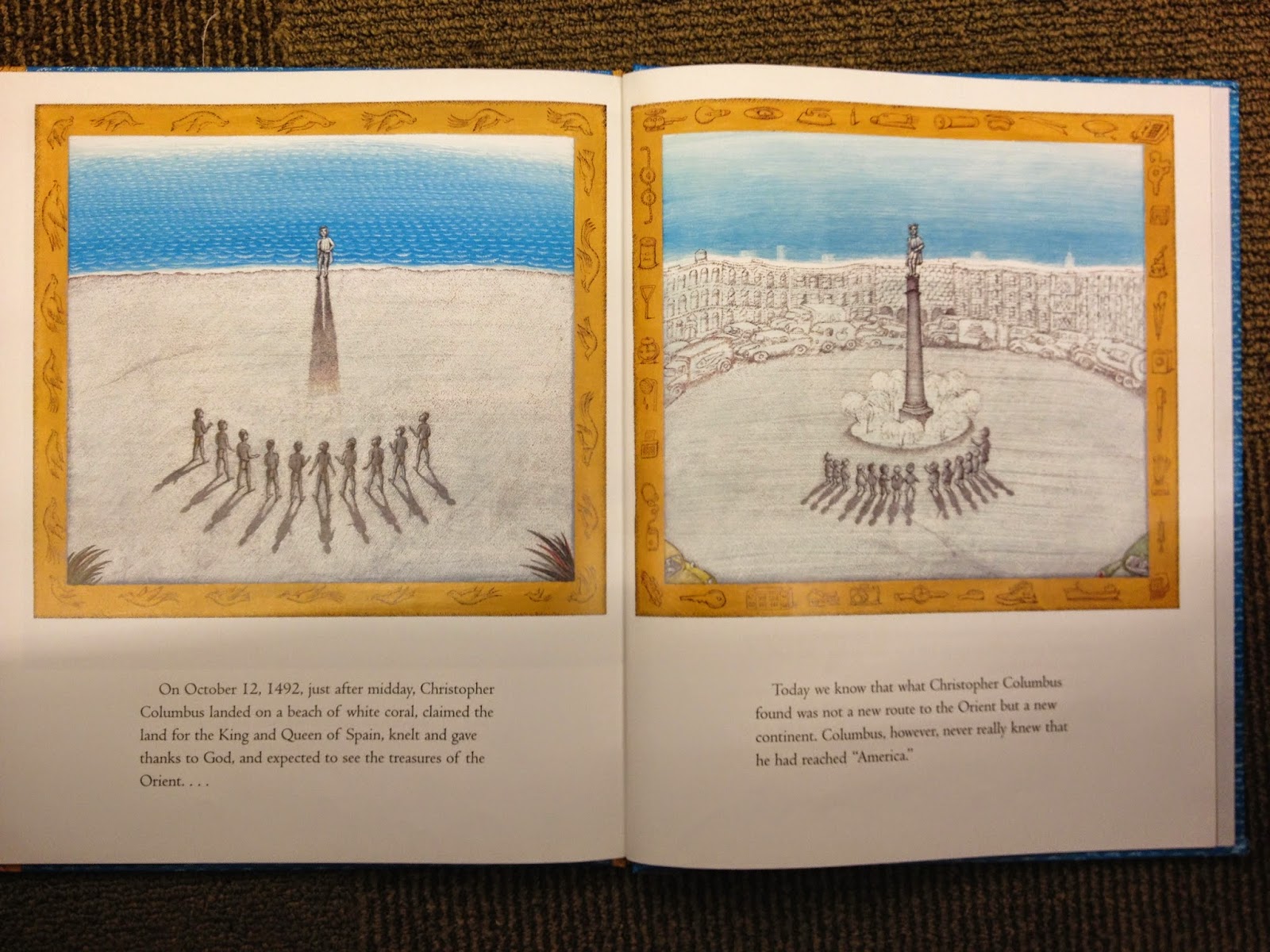In the last few days, I've been looking at picture books about Christopher Columbus. Peter Sis did one, titled Follow the Dream: The Story of Christopher Columbus.
Sis has won a lot of major awards for his work in children's literature, but none (that I know of) for his biography of Columbus.
Published in 1991 (likely timed to coincide with the 500 year 'anniversary' of Columbus landing in the New World), the reviewer at Publisher's Weekly called it flat, while the one at Kirkus called it uncontroversial, and the reviewer at School Library Journal said to "make room on your crowded Columbus shelf" for this one.
Sis grew up in Czechoslovakia. In a 2009 article in Bookbird, Sis wrote (p. 45):
The page on the left shows Columbus when he "landed on a beach of white coral, claimed the land for the King and Queen of Spain, knelt and gave thanks to God, and expected to see the treasures of the Orient..." Not a word about the people he is looking at...
He juxtaposes the illustration of Columbus-the-man with the one on the right. It is a statue of Columbus. It reminds me of the one in Barcelona. Looking closely, I think the figures gathered 'round the statue are schoolchildren. Makes sense, maybe, if he images them to be the children who are intended readers of his book. Fair enough, but nonetheless, the juxtaposition bothers me. On the left are Native people. On the right are children. Another read of the two pages is to equate Native people with children. That is, unfortunately, all too common in children's literature and society, too. Surely you're familiar with the phrase "wild Indian" as used to describe children who are a bit out of control...
Needless to say, I don't recommend Sis's book about Columbus. If you want to read the article in Bookbird, its title is "My Life With Censorship" and it is in volume 47, issue #3, in 2009. And take a look at Desai's article on books about Columbus.
Sis has won a lot of major awards for his work in children's literature, but none (that I know of) for his biography of Columbus.
Published in 1991 (likely timed to coincide with the 500 year 'anniversary' of Columbus landing in the New World), the reviewer at Publisher's Weekly called it flat, while the one at Kirkus called it uncontroversial, and the reviewer at School Library Journal said to "make room on your crowded Columbus shelf" for this one.
Sis grew up in Czechoslovakia. In a 2009 article in Bookbird, Sis wrote (p. 45):
I grew up with the myth of Columbus's voyage and his discovery of the "new world." I thought I had found a perfect explorer in him. Someone who was determined to find the way, just like me. I remember how surprised I was by the voices raised against Columbus and against the consequences of his "conquest." It sounded especially strong on the 500th anniversary of his voyage and it scared me. I was not used to this "free" discussion and I still have to remind myself that everyone has a point of view, even today.His use of quotes around the word 'conquest' suggests he doesn't agree with the people who raise voices against Columbus. He probably wouldn't like what I have to say about this illustration (I took this photo with my phone today while at the library reading books about Columbus):
The page on the left shows Columbus when he "landed on a beach of white coral, claimed the land for the King and Queen of Spain, knelt and gave thanks to God, and expected to see the treasures of the Orient..." Not a word about the people he is looking at...
He juxtaposes the illustration of Columbus-the-man with the one on the right. It is a statue of Columbus. It reminds me of the one in Barcelona. Looking closely, I think the figures gathered 'round the statue are schoolchildren. Makes sense, maybe, if he images them to be the children who are intended readers of his book. Fair enough, but nonetheless, the juxtaposition bothers me. On the left are Native people. On the right are children. Another read of the two pages is to equate Native people with children. That is, unfortunately, all too common in children's literature and society, too. Surely you're familiar with the phrase "wild Indian" as used to describe children who are a bit out of control...
Needless to say, I don't recommend Sis's book about Columbus. If you want to read the article in Bookbird, its title is "My Life With Censorship" and it is in volume 47, issue #3, in 2009. And take a look at Desai's article on books about Columbus.






















